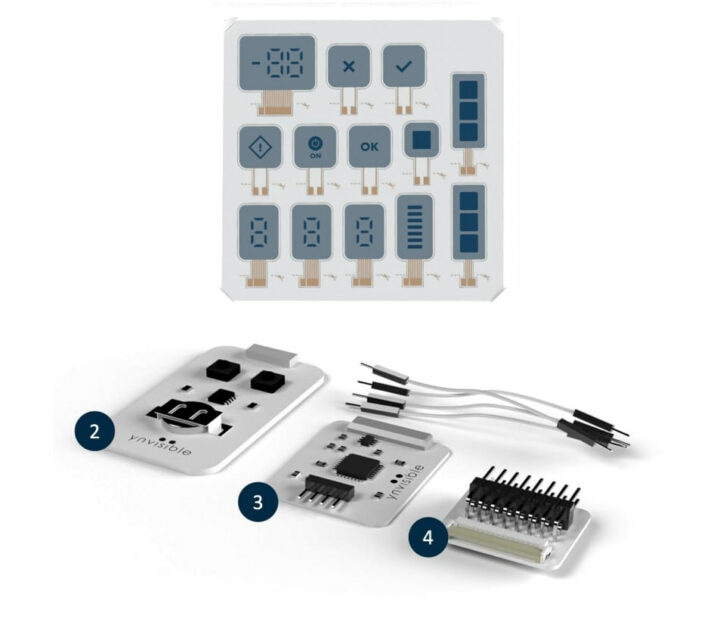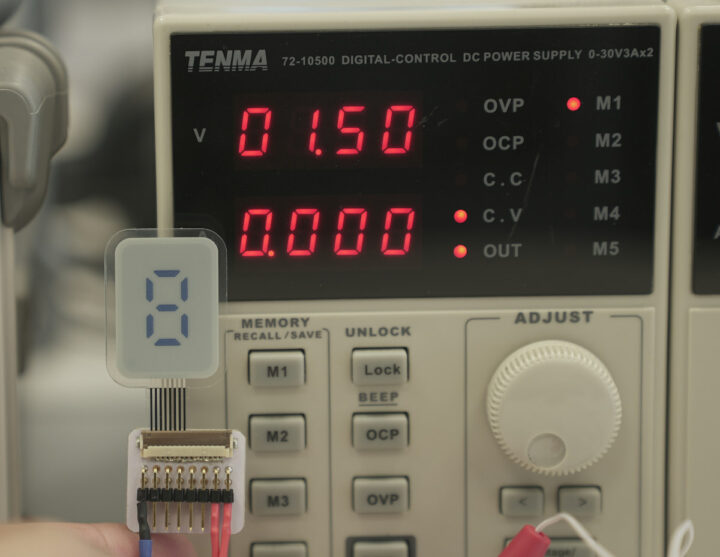Ynvisible Interactive will soon release upgrades to their printed flexible E-paper displays that consume 50% less energy per switch and can last 10 longer when switched on and off, with the company claiming to offer the lowest energy-consuming displays in the e-paper industry.
Those displays are mostly used in specific industries such as digital signage, smart monitoring labels, authenticity & security, and retail. While we have very little information about the new upgrades, I’ve noticed the company is offering a development kit with several “ultra-low-power, thin and flexible Segment E-Paper Displays”, so let’s have a look.
Here are some of the specifications of the displays part of the kit:
- White Reflectance – 40%
- Contrast Ratio (Yb/Yd) – 1:3
- Angle Dependency – No, lambertian
- Thickness – 300 μm (0.3 mm)
- Graphical layout – Segments with 1mm to 100mm dimensions
- Response time – 100-1000 ms
- Driving voltage – 1.5 V (direct drive)
- Energy consumption – 1 mJ/cm^2
- Pulse energy – 0.25 mJ/cm^2
- Image retention w/o power – 1-5 minutes
- Temperature Range – -20°C – +60°C
- Activations/Cycles – 1,000,000
The odd thing is that the display only retains the image for a few minutes without power, so there are using a different technology that some other e-paper displays on the market, and the displays here relies on electrochromic display technology which enables ultra-thin, ultra-low power, and flexibility, but obviously not zero power image retention.
 The development kit comes with 13 of those flexible e-paper displays, a manual display clicker (2) for ON/OFF operations, an I2C display driver (3) that can be connected to an Arduino or other MCU board, and a flexible display adapter (4) connecting to the display via an FFC/FPC connector and to any MCU boards via jumper cables.
The development kit comes with 13 of those flexible e-paper displays, a manual display clicker (2) for ON/OFF operations, an I2C display driver (3) that can be connected to an Arduino or other MCU board, and a flexible display adapter (4) connecting to the display via an FFC/FPC connector and to any MCU boards via jumper cables.
The company provides an Arduino library, some sample code, and instructions to get started with the kit. The guide says “if you purchased displays before February 28th, 2022, please follow this guide instead”, so it’s quite possible the information has already been updated for the new version of the displays.
You can find more details and/or purchase the Segment display kit for 85 Euros on the company’s website. If you are interested in the new display, a webinar will take place at 16.30-17.30 CET / 7.30-8.30 PST on March 15, 2022.

Jean-Luc started CNX Software in 2010 as a part-time endeavor, before quitting his job as a software engineering manager, and starting to write daily news, and reviews full time later in 2011.
Support CNX Software! Donate via cryptocurrencies, become a Patron on Patreon, or purchase goods on Amazon or Aliexpress






Power consumption seems on par with LCD ( 1mJ = 0.25uWh), not sure what the advantage is.
Hmm, this is scary similar to rdotdisplays. Here are some articles about them in Swedish https://etn.se/index.php/component/search/?searchword=rdots&ordering=newest&searchphrase=all&limit=20. Any partner connections?
Update: Here is the connection https://www.ynvisible.com/news-inspiration/ynvisible-delivers-invited-talk-at-idw-20 & https://rdotdisplays.com/investors. Transparency, please…
While I see the connection, I’ve missed the relevance. Can you enlighten us a wee bit? The only thing I noted was rdot tried launching in 2017 and appears to have run out of money…and that this is perhaps an attempt to appear like a brand new company in order to raise more funds?
1M cycles? Seems pretty bad…
It’s 11 days if you display the clock with a resolution of the second 😉
What is exactly the use of eInk display that requires a standby power??? Doesn’t it just defeat the whole idea?